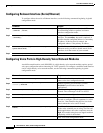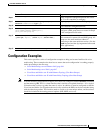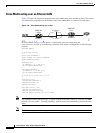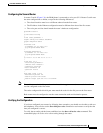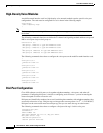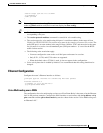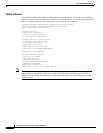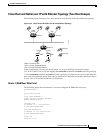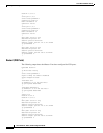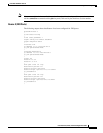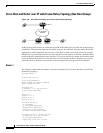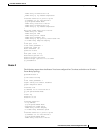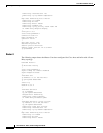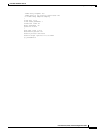
Cisco Hoot and Holler over IP
Configuration Examples
VC-852
Cisco IOS Voice, Video, and Fax Configuration Guide
Cisco Hoot and Holler over IP with Frame-Relay Topology (One Hoot Group)
Figure 136 Cisco Hoot and Holler over IP with Frame Relay Topology
In this topology, three routers are connected using 64K Frame Relay PVCs in a hub-and-spoke topology,
with Router 1 being the hub. One hoot and holler group has been defined. All three routers have been
configured to traffic-shape their data and voice on the WAN to CIR, and all three routers are using IP
RTP priority to guarantee QoS for the Cisco hoot and holler over IP packets. In addition, the Frame Relay
broadcast-queue is disabled on the serial interfaces. This occurs because, by default, the broadcast queue
is only 40 packets deep and Cisco hoot and holler over IP transmits packets at 50 packets per second.
Unless the queue is disabled, some packets would be dropped and voice QoS would be degraded.
Router-1
The following output shows that Router 1 has been configured for Cisco hoot and holler over IP with
Frame Relay topology:
hostname Router-1
!
ip multicast-routing
!
voice class permanent 1
signal timing oos timeout disabled
signal keepalive 65535
!
interface Vif1
ip address 1.1.1.1 255.255.255.0
ip pim sparse-dense-mode
!
router rip
network 1.1.1.0
network 5.5.5.0
network 5.5.6.0
!
interface Serial0/0
no ip address
ip pim sparse-dense-mode
encapsulation frame-relay
frame-relay traffic-shaping
no frame-relay broadcast-queue
!
interface Serial0/0.1 point-to-point
ip address 5.5.5.1 255.255.255.0
ip pim sparse-dense-mode
frame-relay class hoot-n-holler
Router 2
Router 1
Router 3
35838
IP multicast
network




